Hainina is an extinct mammal genus from the latest Cretaceous to the Paleocene of Europe.
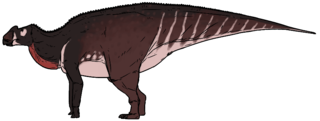
Aralosaurus was a genus of hadrosaurid dinosaur that lived during the Late Cretaceous in what is now Kazakhstan. It is known only by a posterior half of a skull and some post-cranial bones found in the Bostobe Formation in rocks dated from the Upper Santonian-Lower Campanian boundary, at about 83.6 Ma. Only one species is known, Aralosaurus tuberiferus, described by Anatoly Konstantinovich Rozhdestvensky in 1968. The genus name means Aral Sea lizard, because it was found to the northeast of the Aral Sea. The specific epithet tuberiferus means bearing a tuber because the posterior part of the nasal bone rises sharply in front of the orbits like an outgrowth. Aralosaurus was originally reconstituted with a nasal arch similar to that of North American Kritosaurus. For many years, Aralosaurus was thus placed in the clade of the Hadrosaurinae. This classification was invalidated in 2004, following the re-examination of the skull of the animal which allowed to identify in Aralosaurus many typical characters of Lambeosaurinae. In particular, this study revealed that Aralosaurus had a hollow bony structure located far in front of the orbits, which communicated with the respiratory tract. This structure being broken at its base, its shape and size remains undetermined. More recently, Aralosaurus has been identified as the most basal Lambeosaurinae, and placed with its close relative Canardia from the upper Maastrichtian of France in the new clade of Aralosaurini.
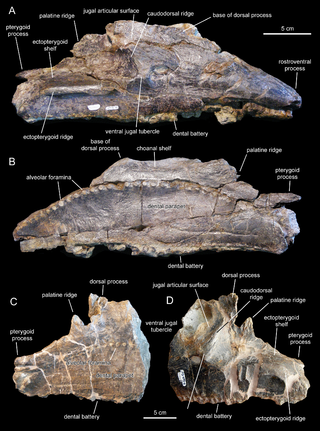
Pararhabdodon is a genus of tsintaosaurin hadrosaurid dinosaur, from the Maastrichtian-age Upper Cretaceous Tremp Group of Spain. The first remains were discovered from the Sant Romà d’Abella fossil locality and assigned to the genus Rhabdodon, and later named as the distinct species Pararhabdodon isonensis in 1993. Known material includes assorted postcranial remains, mostly vertebrae, as well as maxillae from the skull. Specimens from other sites, including remains from France, a maxilla previously considered the distinct taxon Koutalisaurus kohlerorum, an additional maxilla from another locality, the material assigned to the genera Blasisaurus and Arenysaurus, and the extensive Basturs Poble bonebed have been considered at different times to belong to the species, but all of these assignments have more recently been questioned. It was one of the last non-avian dinosaurs known from the fossil record that went extinct during the Cretaceous-Paleogene extinction event.

Doratodon is an extinct genus of Late Cretaceous crocodylomorph that may have been a member of the Sebecosuchia. Doratodon was a relatively small animal with ziphodont teeth, meaning the teeth had flattened sides and serrated edges. Two species of Doratodon are known to science: D. carcharidens from Austria and Hungary, the type species; and D. ibericus from Spain. Teeth similar to those of Doratodon are also known from Italy and Romania, though they cannot be confidently assigned to this genus.

Allodaposuchus is an extinct genus of crocodyliforms that lived in what is now southern Europe during the Campanian and Maastrichtian stages of the Late Cretaceous. Although generally classified as a non-crocodylian eusuchian crocodylomorph, it is sometimes placed as one of the earliest true crocodylians. Allodaposuchus is one of the most common Late Cretaceous crocodylomorphs from Europe, with fossils known from Romania, Spain, and France.

Bothremydidae is an extinct family of side-necked turtles (Pleurodira) known from the Cretaceous and Cenozoic. They are closely related to Podocnemididae, and are amongst the most widely distributed pleurodire groups, with their fossils having been found in Africa, India, the Middle East, Europe, North America and South America. Bothremydids were aquatic turtles with a high morphological diversity, indicative of generalist, molluscivorous, piscivorous and possibly herbivorous grazing diets, with some probably capable of suction feeding. Unlike modern pleurodires, which are exclusively freshwater, bothremydids inhabited freshwater, marine and coastal environments. Their marine habits allowed bothremydids to disperse across oceanic barriers into Europe and North America during the early Late Cretaceous (Cenomanian). The youngest records of the group are indeterminate remains from Saudi Arabia and Oman, dating to the Miocene.
The Arén Formation or Arén Sandstone is a geological formation in the Tremp-Graus Basin around Arén, Catalonia, Spain whose strata date back to the Late Cretaceous. Dinosaur remains are among the fossils that have been recovered from the formation. The formation dates to the Campanian to Maastrichtian and underlies the Tremp Group.

The Tremp Formation, alternatively described as Tremp Group, is a geological formation in the comarca Pallars Jussà, Lleida, Spain. The formation is restricted to the Tremp or Tremp-Graus Basin, a piggyback foreland basin in the Catalonian Pre-Pyrenees. The formation dates to the Maastrichtian to Thanetian, thus the formation includes the Cretaceous-Paleogene boundary that has been well studied in the area, using paleomagnetism and carbon and oxygen isotopes. The formation comprises several lithologies, from sandstone, conglomerates and shales to marls, siltstones, limestones and lignite and gypsum beds and ranges between 250 and 800 metres in thickness. The Tremp Formation was deposited in a continental to marginally marine fluvial-lacustrine environment characterized by estuarine to deltaic settings.

Arenysaurus is a genus of hadrosaurid dinosaur from the Late Cretaceous, being one of the last non-avian dinosaurs and it went extinct during the Cretaceous–Paleogene extinction event. It is known from a partial skull and skeleton found in the late Maastrichtian-age Tremp Formation of the Pyrenees Mountains in Spain. The type species is A. ardevoli, described in 2009 by Pereda-Suberbiola et al., a group of researchers from Spain. The genus name refers to Arén, where it was found, and the specific epithet honours geologist Lluís Ardèvol.
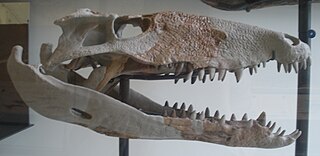
Sebecidae is an extinct family of prehistoric terrestrial sebecosuchian crocodylomorphs, known from the Late Cretaceous and Cenozoic of Europe and South America. They were the latest surviving group of non-crocodilian crocodylomorphs.
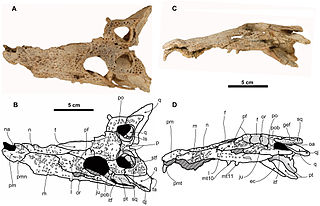
Arenysuchus is an extinct monospecific genus of allodaposuchid eusuchian crocodylomorph from Late Cretaceous deposits of north Spain. It is known from the holotype MPZ ELI-1, a partial skull from Elías site, and from the referred material MPZ2010/948, MPZ2010/949, MPZ2010/950 and MPZ2010/951, four teeth from Blasi 2 site. It was found by the researchers José Manuel Gasca and Ainara Badiola from the Tremp Formation, in Arén of Huesca, Spain. It was first named by Eduardo Puértolas, José I. Canudo and Penélope Cruzado-Caballero in 2011 and the type species is Arenysuchus gascabadiolorum.

Foxemys is an extinct genus of bothremydid turtle that was discovered at Fox Amphoux, France and also Hungary and Spain. Its skull and shell structure is similar to Polysternon. Two species are in the genus: F. mechinorum and F. trabanti.
Laño is a hamlet and concejo in Condado de Treviño within the Treviño enclave; which is administratively part of the Spanish province of Burgos, but which is completely surrounded by the territory of the Basque country province of Álava. It is best known for the fossils of extinct vertebrates dating from around 70 million years before present which have been found there.

Agaresuchus is an extinct genus of allodaposuchid eusuchian crocodylomorph from the Late Cretaceous (Campanian-Maastrichtian) of Spain. It includes two species, the type species Agaresuchus fontisensis, and Agaresuchus subjuniperus, which was originally named as a species of the related genus Allodaposuchus. However, it has been proposed that both species may instead belong to the genus Allodaposuchus.

Adynomosaurus is a genus of lambeosaurine dinosaur from the Late Cretaceous of what is now Catalonia, Spain. First discovered in 2012, it was named in 2019 with the type and only species being Adynomosaurus arcanus. It is only known from scant material, but is distinguished from other hadrosaurs by its weakly developed shoulder blade which would have had underdeveloped musculature, which lends it its scientific name, partially from the Greek word for "weak". Its exact relationships with other hadrosaurs remain unresolved, with it not consistently being recovered as a relative of any other specific genera, though some studies have allied it with Tsintaosaurini or even found it outside of Hadrosauridae. It would have lived as part of a diverse coastal estuary ecosystem, made up of meandering rivers and mud flats. The discovery of Adynomosaurus adds to the very incomplete fossil record of hadrosaurid dinosaurs in the Late Cretaceous of Europe, and it fits into a picture of major ecological turnover that was occurring during the Maastrichtian stage in the region.

Pareisactus is a genus of rhabdodontid ornithopod dinosaur from the Late Cretaceous Conquès Member of the Tremp Formation in the Southern Pyrenees of Spain. The type and only species is P. evrostos, known only from a single scapula.
Ogresuchus is an extinct sebecid known from the Upper Cretaceous Tremp Formation in Spain. It is the oldest known member of the Sebecidae and it is also the only known Mesozoic sebecid. The type species, O. furatus, was named in 2020. It was a small crocodilian, measuring 1.09 m (3.6 ft) long and weighing about 9 kg (20 lb).

Tamarro is a genus of troodontid theropod from the Late Cretaceous Talarn Formation of Spain. The genus contains a single species, Tamarro insperatus, known from a partial metatarsal described in 2021.

Abditosaurus is an extinct genus of titanosaurian sauropod dinosaur from the Late Cretaceous (Maastrichtian) Tremp Group of Catalonia, Spain. The type and only species is Abditosaurus kuehnei. Phylogenetic analyses recover it within a clade of South American and African saltasaurines, distinct from other insular dwarf sauropods from the European archipelago. Abditosaurus inhabited the Ibero-Armorican Island, a prehistoric island made up of what is now Spain, Portugal, and southern France, and would have been the largest titanosaur species in its environment.
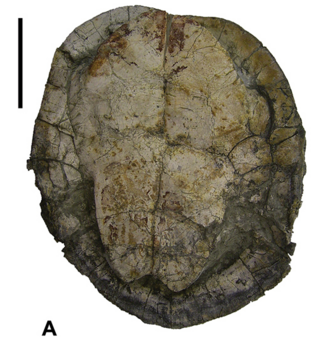
Iberoccitanemys is an extinct genus of turtle from the Bothremydidae that is known from the Marnes d'Auzas Formation in France, and also the Sobrepena Formation and Villalba de la Sierra Formation in Spain.
















